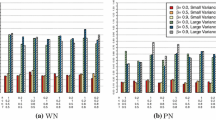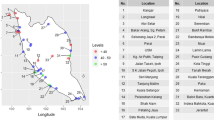Abstract
Modeling spatio-temporal count processes is often a challenging endeavor. That is, in many real-world applications the complexity and high-dimensionality of the data and/or process do not allow for routine model specification. For example, spatio-temporal count data often exhibit temporally varying over/underdispersion within the spatial domain. In order to accommodate such structure, while quantifying different sources of uncertainty, we propose a Bayesian spatio-temporal Conway–Maxwell Poisson (CMP) model with dynamic dispersion. Motivated by the problem of predicting migratory bird settling patterns, we propose a threshold vector-autoregressive model for the CMP intensity parameter that allows for regime switching based on climate conditions. Additionally, to reduce the inherent high-dimensionality of the underlying process, we consider nonlinear dimension reduction through kernel principal component analysis. Finally, we demonstrate the effectiveness of our approach through out-of-sample one-year-ahead prediction of waterfowl migratory patterns across the United States and Canada. The proposed approach is of independent interest and illustrates the potential benefits of dynamic dispersion in terms of superior forecasting.
This article has supplementary material online.
Similar content being viewed by others
References
Berliner, L. (1996), “Hierarchical Bayesian Time-Series Models,” Fundamental Theories of Physics, 79, 15–22.
Brooks, S., and Gelman, A. (1998), “General Methods for Monitoring Convergence of Iterative Simulations,” Journal of Computational and Graphical Statistics, 7 (4), 434–455.
Cameron, A., and Trivedi, P. (1998), Regression Analysis of Count Data, Vol. 30, Cambridge: Cambridge University Press.
Carlin, B., and Banerjee, S. (2003), “Hierarchical Multivariate CAR Models for Spatio-Temporally Correlated Survival Data,” Bayesian Statistics, 7, 45–64.
Conway, R., and Maxwell, W. (1962), “A Queuing Model With State Dependent Service Rates,” Journal of Industrial Engineering, 12, 2.
Cressie, N., and Wikle, C. (2011), Statistics for Spatio-Temporal Data, New York: Wiley.
Guikema, S., and Goffelt, J. (2008), “A Flexible Count Data Regression Model for Risk Analysis,” Risk Analysis, 28 (1), 213–223.
Hansen, H., and McKnight, D. (1964), “Emigration of Drought-Displaced Ducks to the Arctic,” in Transactions of the North American Wildlife and Natural Resources Conference, Vol. 29, pp. 119–127.
Herbers, J. M. (1989), “Community Structure in North Temperate Ants: Temporal and Spatial Variation,” Oecologia, 81 (2), 201–211.
Hilbe, J. (2011), Negative Binomial Regression, Cambridge: Cambridge University Press.
Hooten, M., Wikle, C., Dorazio, R., and Royle, J. (2007), “Hierarchical Spatio-Temporal Matrix Models for Characterizing Invasions,” Biometrics, 63 (2), 558–567.
Johnson, D., and Grier, J. (1988), “Determinants of Breeding Distributions of Ducks,” in Wildlife Monographs, pp. 3–37.
Jolliffe, I. (2010), Principal Component Analysis, Berlin: Springer.
Minka, T., Shmueli, G., Kadane, J., Borle, S., and Boatwright, P. (2003), Computing with the COM-Poisson Distribution. Pittsburgh: Department of Statistics, Carnegie Mellon University.
R Development Core Team (2012), R: A Language and Environment for Statistical Computing. Vienna: R Foundation for Statistical Computing. ISBN:3-900051-07-0
Ridout, M. S., and Besbeas, P. (2004), “An Empirical Model for Underdispersed Count Data,” Statistical Modelling, 4 (1), 77–89.
Robert, C., and Casella, G. (2004), Monte Carlo Statistical Methods, Berlin: Springer.
Schölkopf, B., Smola, A., and Müller, K. (1998), “Nonlinear Component Analysis as a Kernel Eigenvalue Problem,” Neural Computation, 10 (5), 1299–1319.
Sellers, K., Borle, S., and Shmueli, G. (2012), “The COM-Poisson Model for Count Data: A Survey of Methods and Applications,” Applied Stochastic Models in Business and Industry, 28, 104–116.
Sellers, K., and Shmueli, G. (2010), “A Flexible Regression Model for Count Data,” The Annals of Applied Statistics, 4 (2), 943–961.
Shawe, J., and Cristianini, N. (2004), Kernel Methods for Pattern Analysis, Cambridge: Cambridge University Press.
Shmueli, G., Minka, T., Kadane, J., Borle, S., and Boatwright, P. (2005), “A Useful Distribution for Fitting Discrete Data: Revival of the Conway–Maxwell–Poisson Distribution,” Journal of the Royal Statistical Society. Series C. Applied Statistics, 54 (1) 127–142.
Sorenson, L., Goldberg, R., Root, T., and Anderson, M. (1998), “Potential Effects of Global Warming on Waterfowl Populations Breeding in the Northern Great Plains,” Climatic Change, 40 (2), 343–369.
Van der Maaten, L., Postma, E., and Van den Herik, H. (2008). ”Dimensionality Reduction: A Comparative Review.” Online Preprint.
Ver Hoef, J., and Boveng, P. (2007), “Quasi-Poisson Vs. Negative Binomial Regression: How Should We Model Overdispersed Count Data?,” Ecology, 88 (11), 2766–2772.
Waller, L., Carlin, B., Xia, H., and Gelfand, A. (1997), “Hierarchical Spatio-Temporal Mapping of Disease Rates,” Journal of the American Statistical Association, 92 (438), 607–617.
Wang, J., and Holan, S. (2012), “Bayesian Multi-Regime Smooth Transition Regression With Ordered Categorical Variables,” Computational Statistics & Data Analysis, 56 (2), 4165–4179.
Wikle, C. (2003), “Hierarchical Bayesian Models for Predicting the Spread of Ecological Processes,” Ecology, 84 (6), 1382–1394.
— (2010), Handbook of Spatial Statistics, London/Boca Raton: Chapman and Hall/CRC.
Wikle, C., and Berliner, L. (2005), “Combining Information Across Spatial Scales,” Techonmetrics, 47, 80–91.
Wikle, C., and Cressie, N. (1999), “A Dimension-Reduced Approach to Space-Time Kalman Filtering,” Biometrika, 86 (4), 815.
Wikle, C., and Holan, S. (2011), “Polynomial Nonlinear Spatio-Temporal Integro-Difference Equation Models,” Journal of Time Series Analysis, 32 (4), 339–350.
Wikle, C., and Hooten, M. (2006), “Hierarchical Bayesian Spatio-Temporal Models for Population Spread,” in Applications of Computational Statistics in the Environmental Sciences: Hierarchical Bayes and MCMC Methods, pp. 145–169.
— (2010), “A General Science-Based Framework for Dynamical Spatio-Temporal Models,” Test, 19 (3), 417–451.
Wikle, C., Milliff, R., Nychka, D., and Berliner, L. (2001), “Spatio-Temporal Hierarchical Bayesian Modeling Tropical Ocean Surface Winds,” Journal of the American Statistical Association, 96 (454), 382–397.
Zhuang, L., and Cressie, N. (2012), “Spatio-Temporal Modeling of Sudden Infant Death Syndrome Data,” Statistical Methodology, 9 (1), 117–143.
Author information
Authors and Affiliations
Corresponding author
Electronic Supplementary Material
Below is the link to the electronic supplementary material.
Rights and permissions
About this article
Cite this article
Wu, G., Holan, S.H. & Wikle, C.K. Hierarchical Bayesian Spatio-Temporal Conway–Maxwell Poisson Models with Dynamic Dispersion. JABES 18, 335–356 (2013). https://doi.org/10.1007/s13253-013-0141-2
Published:
Issue Date:
DOI: https://doi.org/10.1007/s13253-013-0141-2




